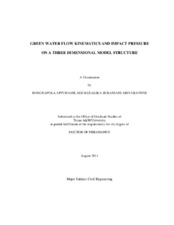| dc.contributor.advisor | Chang, Kuang-An | |
| dc.creator | Ariyarathne, Hanchapola Appuhamilage Kusalika Suranjani | |
| dc.date.accessioned | 2011-10-21T22:03:48Z | |
| dc.date.accessioned | 2011-10-22T07:12:34Z | |
| dc.date.available | 2011-10-21T22:03:48Z | |
| dc.date.available | 2011-10-22T07:12:34Z | |
| dc.date.created | 2011-08 | |
| dc.date.issued | 2011-10-21 | |
| dc.date.submitted | August 2011 | |
| dc.identifier.uri | https://hdl.handle.net/1969.1/ETD-TAMU-2011-08-9875 | |
| dc.description.abstract | Flow kinematics of green water due to plunging breaking waves interacting with a simplified, three-dimensional model structure was investigated in laboratory. Two breaking wave conditions were tested: one with waves impinging and breaking on the vertical wall of the model at the still water level and the other with waves impinging and breaking on the horizontal deck surface. The incoming wave parameters were selected similar to observed wave parameters for the maximum wave height for Hurricane Ivan based on Froude scaling. The Bubble Image Velocimetry (BIV) technique was used to measure the flow velocity. Measurements were taken on a vertical plane located at the center of the deck surface and a horizontal plane located slightly above the deck surface.
The evolution of green water flow kinematics in time and space is revealed in the study. The unsteady and non-uniform velocities were found to be quite different between the two wave conditions, even though the incoming waves are nearly identical. It was observed that the maximum velocity appears near the green water wave front and is 1.44C with C being the wave phase speed for the deck impingement case and 1.24C for wall impingement case. The velocity variations in the present study were compared with that in an earlier study using a two-dimensional model with the same wave condition as in the wall impingement condition. It was found that the magnitudes of the maximum vertical velocity is very different between these two models (1.7C in the 3D model versus 2.9C in the 2D model), whereas the magnitudes of the maximum horizontal velocity on the deck are very similar (1.2C in both 3D and 2D models).
The applicability of dam-break theory on green water velocity prediction for the three-dimensional model was also investigated. It was found that the dam-break theory works very well in terms of predicting the maximum velocity, which is also the front velocity, but not the spatial distribution of the velocity on the deck.
Furthermore, pressure measurements were performed at two vertical planes: one at the centre and the other at 0.05 m away from the centre. Ensemble averaged pressure variations were compared. Two types of pressure variations, impulsive type and non-impulsive type were observed. Impact pressure was successfully related to the pressure rising time. Void fraction was measured for few locations near the model front edge. Predictions of maximum impact pressure based on the measured pressure and flow velocity were investigated linking pressure with kinetic energy. Constant impact coefficient of 1.3 was found for wall impingement wave. However, for deck impingement wave, it was not possible to find a constant impact coefficient. It was also found that there is a linear relationship between the rising pressure gradient and the impact coefficient. | en |
| dc.format.mimetype | application/pdf | |
| dc.language.iso | en_US | |
| dc.subject | Green water
Flow kinematics | en |
| dc.subject | Impact pressure | en |
| dc.title | Green Water Flow Kinematics and Impact Pressure on a Three Dimensional Model Structure | en |
| dc.type | Thesis | en |
| thesis.degree.department | Civil Engineering | en |
| thesis.degree.discipline | Civil Engineering | en |
| thesis.degree.grantor | Texas A&M University | en |
| thesis.degree.name | Doctor of Philosophy | en |
| thesis.degree.level | Doctoral | en |
| dc.contributor.committeeMember | Mercier, Richard | |
| dc.contributor.committeeMember | Chen, Hamn-Ching | |
| dc.contributor.committeeMember | Stoessel, Achim | |
| dc.type.genre | thesis | en |
| dc.type.material | text | en |


